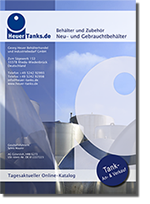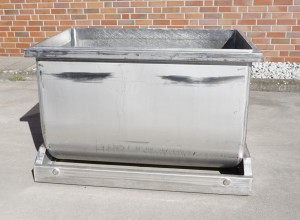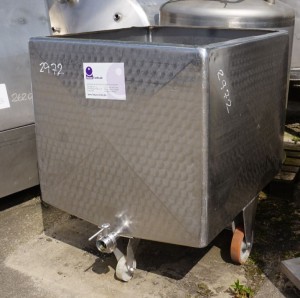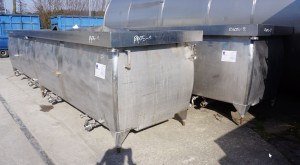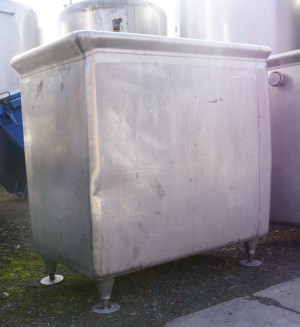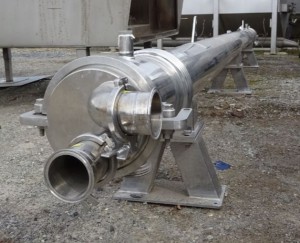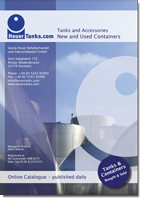Wine tank for foodstuffs
Wine tank
Basin 600 liters made of V2A, single-walled, used
Art.-Nr. M-3035
EUR 920,00
add. 19 % VAT excl. shipping costs
Wanne 600 Liter aus V2A, einwandig, gebraucht
EUR 920,00
add. 19 % VAT excl. shipping costs
Basin 700 liters made of V2A, single-walled, used
Art.-Nr. M-2972
EUR 800,00
add. 19 % VAT excl. shipping costs
Wanne 700 Liter aus V2A, einwandig, gebraucht
EUR 800,00
add. 19 % VAT excl. shipping costs
Basin 8.000 liters made of V4A, single-walled, used
Art.-Nr. M-2605
EUR 5.700,00
add. 19 % VAT excl. shipping costs
Wanne 8.000 Liter aus V4A, einwandig, gebraucht
EUR 5.700,00
add. 19 % VAT excl. shipping costs
Basin 800 liters made of V4A, single-walled, used
Art.-Nr. M-2613
EUR 1.100,00
add. 19 % VAT excl. shipping costs
Wanne 800 Liter aus V4A, einwandig, gebraucht
EUR 1.100,00
add. 19 % VAT excl. shipping costs
Wine tank
Similar to beer tanks, wine tanks are foodstuff tanks. Wine tanks also come in different types. For example, there’s a transport tank which can transport wine from the vineyard to the bottling facility in large quantities. There are also pressure tanks which are needed particularly for the production of sparkling and semi-sparkling wine. Wine is mostly produced from grapes or grape must. This is how you can differentiate red wine production from white wine production.
White wine production
White wine is processed reductively and the grapes are fermented into wine. Just like in beer brewing, the individual production steps must be followed. The first step in wine production is mashing. This involves removing the grapes from their stems and pressing them into a viscous mixture. Then, what’s referred to as the mash is pressed in a wine press. It’s important to gently press the mash so that the wine won’t be bitter. After the must has been separated from the remains of the grapes, it can then be enriched. However, this is not permitted in all countries, as enriching the wine increases its alcohol content. Another step is sulphurisation, which prevents the wine from turning brown as well as hindering the growth of other micro-organisms that are not beneficial the wine.
Anaerobic digestion of white wine
In the next step, the anaerobic digestion process, an anaerobic digestion tank is needed. The main digestion process generally takes six to eight days. As the must can warm up during this digestion, many anaerobic digestion tanks feature temperature regulation. The cooler the wine digests at, the lighter it becomes. After anaerobic digestion comes the racking. This involves sucking the wine out of the tank, usually from above so that the yeast that has sunk down isn’t removed along with the wine. The wine then needs to rest and mature. This generally takes place in wooden barrels, glass and plastic containers or steel tanks. These storage tanks provide the wine with the perfect environment to reach their full potential.
Red wine production
There are only a few small things which differentiate red wine production from white wine production. The biggest difference is the order in which the steps are carried out. The first step, the mashing, remains the same.
Anaerobic digestion of the mash
In the next step, the mash must undergo anaerobic digestion and isn’t pressed straight away like white wine. This process generally starts by itself since the yeast is still present. Winemakers sometimes give the mash additional yeast that they’ve chosen in order to better control how and by what means the wine is digested. Sometimes the digestion process takes several weeks. This depends on the temperature, as the colder the temperature, the slower the mash is digested. After anaerobic digestion, the mash is pressed.
Aging red wine
Red wines are often aged in wooden barrels. The aging process is another step in wine production. Aging for longer is more cost-intensive but often produces wine of higher quality. The final step is maturation. Some red wines remain drinkable for more than ten years. This depends on the variety of grape and the processing and quality of the wine.

